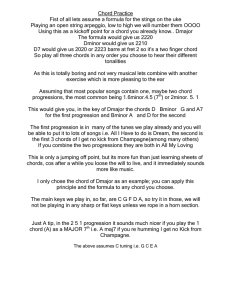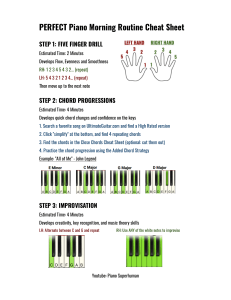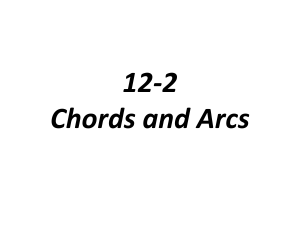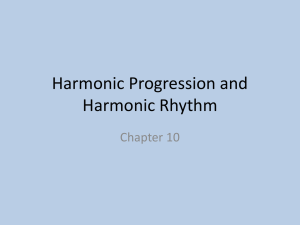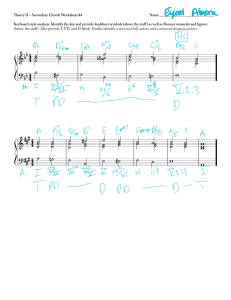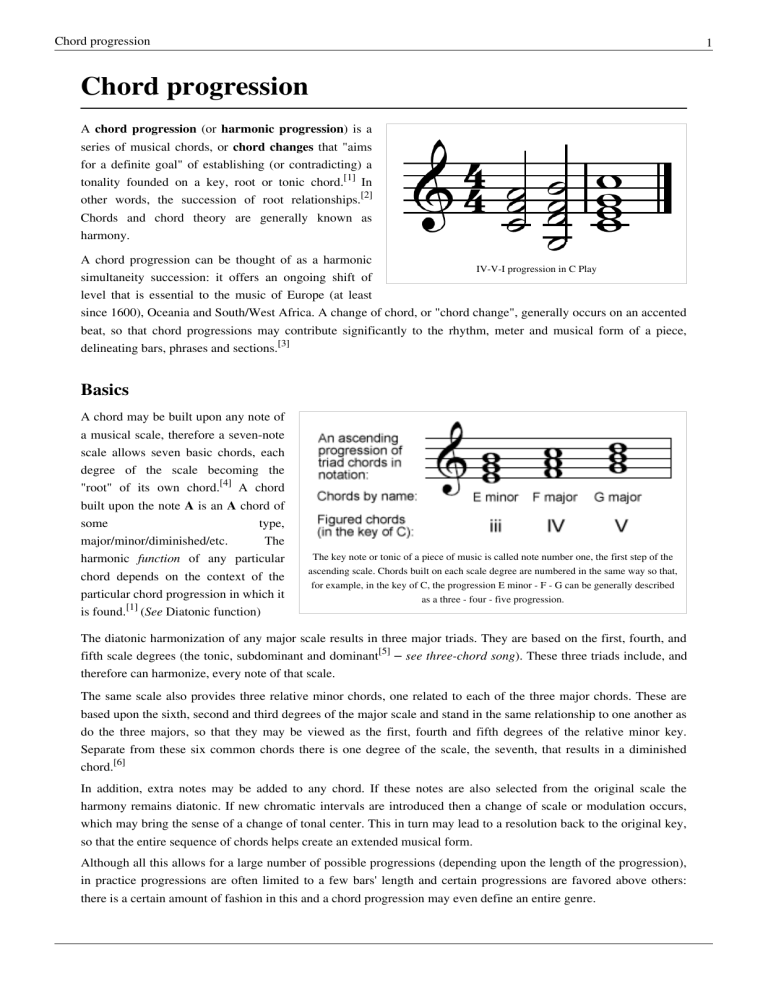
Chord progression 1 Chord progression A chord progression (or harmonic progression) is a series of musical chords, or chord changes that "aims for a definite goal" of establishing (or contradicting) a tonality founded on a key, root or tonic chord.[1] In other words, the succession of root relationships.[2] Chords and chord theory are generally known as harmony. A chord progression can be thought of as a harmonic IV-V-I progression in C Play simultaneity succession: it offers an ongoing shift of level that is essential to the music of Europe (at least since 1600), Oceania and South/West Africa. A change of chord, or "chord change", generally occurs on an accented beat, so that chord progressions may contribute significantly to the rhythm, meter and musical form of a piece, delineating bars, phrases and sections.[3] Basics A chord may be built upon any note of a musical scale, therefore a seven-note scale allows seven basic chords, each degree of the scale becoming the "root" of its own chord.[4] A chord built upon the note A is an A chord of some type, major/minor/diminished/etc. The harmonic function of any particular chord depends on the context of the particular chord progression in which it is found.[1] (See Diatonic function) The key note or tonic of a piece of music is called note number one, the first step of the ascending scale. Chords built on each scale degree are numbered in the same way so that, for example, in the key of C, the progression E minor - F - G can be generally described as a three - four - five progression. The diatonic harmonization of any major scale results in three major triads. They are based on the first, fourth, and fifth scale degrees (the tonic, subdominant and dominant[5] – see three-chord song). These three triads include, and therefore can harmonize, every note of that scale. The same scale also provides three relative minor chords, one related to each of the three major chords. These are based upon the sixth, second and third degrees of the major scale and stand in the same relationship to one another as do the three majors, so that they may be viewed as the first, fourth and fifth degrees of the relative minor key. Separate from these six common chords there is one degree of the scale, the seventh, that results in a diminished chord.[6] In addition, extra notes may be added to any chord. If these notes are also selected from the original scale the harmony remains diatonic. If new chromatic intervals are introduced then a change of scale or modulation occurs, which may bring the sense of a change of tonal center. This in turn may lead to a resolution back to the original key, so that the entire sequence of chords helps create an extended musical form. Although all this allows for a large number of possible progressions (depending upon the length of the progression), in practice progressions are often limited to a few bars' length and certain progressions are favored above others: there is a certain amount of fashion in this and a chord progression may even define an entire genre. Chord progression 2 In western classical notation chords built on the scale are numbered with Roman numerals. A D chord will be figured I in the key of D, for example, but IV in the key of A. Minor chords are signified by lower case Roman, so that D minor in the key of C would be written ii. Other forms of chord notation have been devised, from figured bass to the chord chart. These usually allow or even require a certain amount of improvisation. Simple progressions Diatonic scales such as the major and minor scales lend themselves particularly well to the construction of common chords because they contain a large number of perfect fifths. Such scales predominate in those regions where harmony is an essential part of music, as, for example, in the common practice period of western classical music. On the other hand Arab and Indian music, though they use diatonic scales, also have a number of non-diatonic scales available because the music has no chord changes: it remains always upon the key-chord, as does a certain amount of hard rock, hip hop,[7] funk, disco, [8] jazz,[9] etc. Alternation between two chords may be thought of as the most basic chord progression. Many well-known pieces are built harmonically upon the mere repetition of two chords of the same scale.[1] For example, many of the more straightforward melodies in classical music (e.g., Jeremiah Clarke's Trumpet Voluntary) consist entirely or mostly of alternation between the tonic (I) and the dominant (V, sometimes with an added seventh), as do folk songs such as "Polly Wolly Doodle" and popular songs such as "Achy Breaky Heart". Erik Satie's first Gymnopédie for piano and the Velvet Underground's "Heroin" are both built upon a repeated I - IV, while The Isley Brothers' "Shout" and Bob Marley and King Sporty's "Buffalo Soldier" both use I - vi (the former throughout, the latter for the verses).[10] Three-chord progressions Three-chord tunes, though, are more common, since a melody may then dwell on any note of the scale. Often the chords may be selected to fit a pre-conceived melody, but just as often it is the progression itself that gives rise to the melody. The three-chord I - IV - V progression, a particularly popular kind of circle progression (see below), can be placed into a four-bar phrase in several ways that have been put to endless use in popular music. Ottman[11] gives examples of favoured progressions: • I - IV - V - V. (The basis of Ritchie Valens' "La Bamba", this progression also provides the refrain of Bob Dylan's "Like a Rolling Stone", The Isley Brothers' "Twist and Shout", and The Beatles's "Lucy in the Sky with Diamonds".) • I - I - IV - V. (Millie Small's "My Boy Lollipop" (usually credited to Robert Spencer, Morris Levy, and Johnny Roberts), "Heartbeat" (written by Bob Montgomery and Norman Petty for Buddy Holly), The Rolling Stones' "Get Off Of My Cloud" (refrain), Paul Simon's "Diamonds on the Soles of Her Shoes", Van Morrison's "Madame George", The Ramones' "Blitzkrieg Bop") Beethoven imagined composing his Pastoral Symphony • I - IV - I - V. (Common in Elizabethan music (Scholes 1977), this also underpins the American college song "Goodnight Ladies", is used the exclusive progression used in Kwela,[12] and Solomon Linda's "Mbube"/"Wimoweh"/"The Lion Sleeps Tonight" among many others.) • I - IV - V - IV. (Chip Taylor's/The Troggs' "Wild Thing", "Louie Louie", etc.) Chord progression 3 This basic harmonic pattern occurs in many other pop songs—the output of Phil Spector might also be cited. Similar progressions abound in African popular music. They may be varied by the addition of sevenths (or other scale degrees) to any chord or by substitution of the relative minor of the IV chord to give, for example, I - ii - V. This last is heard, for example, in The Beach Boys' "Good Vibrations" ("Got to keep those...."). This IV-V-I progression in C Play sequence, using the chord based on the second scale degree, is also used cadentially in a common chord progression of jazz harmony, the so-called ii-V-I turnaround, on which are based the more ornate Coltrane changes. Such progressions provide the entire harmonic foundation of much African and American popular music, and they occur sectionally in many pieces of classical music (such as the opening bars of Beethoven's Pastoral Symphony). Any of these progressions may be transposed into any key so that, for instance, the progression I - IV - V in the key of A will be played A - D - E, while in the key of C the chords will be C - F - G. Where such a simple sequence does not represent the entire harmonic structure of a piece, it may readily be extended for greater variety. Frequently an opening phrase of the type I - IV - V - V, which ends on an unresolved dominant, may be "answered" by a similar version that resolves back onto the home chord, giving a structure of double the length: • I - IV - V - V • I - IV - V - I Additionally, such a passage may be alternated with a different progression to give a simple binary or ternary form such as that of the popular thirty-two-bar form (see musical form). Blues changes The twelve bar blues and its many variants use an elongated, three-line form of the I - IV - V progression that has also generated countless hit records, including the most significant output of rock and rollers such as Chuck Berry and Little Richard. In its most elementary form (there are many variants) the chords progress as follows: • I-I-I-I • IV - IV - I - I • V-V-I-I Blues progressions influenced a great deal of 20th century American popular music Chord progression 4 Again, blues progressions have formed the entire harmonic basis of many recorded songs but may also be confined to a single section of a more elaborate form, as frequently with The Beatles in such songs as "You Can't Do That", "I Feel Fine", and "She's A Woman". They have also been subjected to densely chromatic elaboration, as in the work of Charlie Parker. Steedman (1984) proposed that a set of recursive rewrite rules generate all well-formed transformations of jazz, both basic blues chord changes and slightly modified sequences (such as the "rhythm changes"). Important transformations include: ii-V-I turnaround in C Play • • • • replacement of (or addition to) a chord with its dominant, subdominant or the tritone substitution. use of chromatic passing chords. extensively applying the ii-V-I turnaround. chord alterations such as minor chords, diminished sevenths, etc.[13] 50s progression Another common way of extending the I - IV - V sequence is by adding the chord of the sixth scale degree, giving the sequence I - vi - IV - V or I - vi - ii V, sometimes called the 50s progression. The Mills Brothers' recording of "Till Then" looked forward both to the end of World War II and to the popular music of the 1950s. (Courtesy of the Fraser MacPherson estate c/o Guy MacPherson) In fact this sequence had been in use from the earliest days of classical music (used often by Wolfgang Amadeus Mozart), but after generating popular hits such as Rogers and Hart's "Blue Moon" (1934), Jerome Kern and Dorothy Fields' 1936 "The Way You Look Tonight" and Hoagy Carmichael's "Heart and Soul" 50s progression in C, ending with C Play (1938), it became associated with the black American vocal groups of the 1940s, The Ink Spots and The Mills Brothers ("Till Then"), and thus later became the entire basis of the 1950s doo-wop genre, a typical example being The Monotones' "The Book of Love". Taken up into the pop mainstream, for example with Felice and Boudleaux Bryant's "All I Have to Do Is Dream", a hit for The Everly Brothers, in the 1960s it continued to generate records as otherwise disparate as The Paris Sisters' Chord progression 5 "I Love How You Love Me" (written by Mann and Kolber) and Boris Pickett's "Monster Mash". It continued to be used sectionally, as in the refrain of The Beatles' "Girl", and also to form the harmonic basis of further new songs for decades ("Every Breath You Take" by The Police, "Don't Get Me Wrong" by The Pretenders). Circle progressions Introducing the ii chord into these progressions emphasises their appeal as constituting elementary forms of circle progression. These, named for the circle of fifths, consist of "adjacent roots in ascending fourth or descending fifth relationship"—for instance, the sequence vi - ii - V - I ascends with each successive chord to one a fourth above the previous. Such a motion, based upon close harmonic relations, offers "undoubtedly the most common and the strongest of all harmonic progressions".[14] The succession of cadences gives an impression of inevitable return to the key-note of the piece. Circle progression in C major Play. Short cyclical progressions may be derived by selecting a sequence of chords from the series completing a circle from the tonic through all seven diatonic chords[14] : • I - IV - viio - iii - vi - ii - V - I (in C major) Circle progression in C major The ragtime progression (E7-A7-D7-G7) often appears in the bridge of jazz standards [15] (Play). The III7-VI7-II7-V7 (or V7/V/V/V - V7/V/V - V7/V - V7) leads back to C major (I) but is itself indefinite in key. • I - V - I Circle progression excerpt: I-V-I • I - IV - V - I Circle progression excerpt: I - IV -V - I This type of progression was much used by classical composers, who introduced increasingly subtle inflections. Particularly, substitution of major for minor chords giving, for example, I - VI - II - V allowed a more sophisticated chromaticism as well as the possibility of modulation. These harmonic conventions were taken up by American popular entertainers, giving rise to many variations on those harmonic staples of early jazz that have been dubbed the ragtime progression and the stomp progression. All such progressions may be found used sectionally, as for example in the much-used "rhythm changes" of George Gershwin's "I Got Rhythm". Harmonizing the scale As well as the cyclical underpinning of chords, the ear tends to respond well to a linear thread; chords following the scale upwards or downwards. In the 17th century, descending bass lines found favour for "divisions on the ground", so that Pachelbel's canon, the Bach orchestral suites (the famous Air on a G String), and Handel's organ concerti all contain very similar harmonisations of the descending major scale. When this was reintroduced into mid-20th century pop music, it brought with it many baroque trappings (The Beatles' "For No One", Procol Harum's "A Whiter Shade of Pale", and The Steve Miller Band's "Dear Mary" and "Baby's House"). At its simplest, this descending sequence may simply introduce an extra chord, either III or V, into the I - VI - IV V type of sequence described above. This chord allows the harmonisation of the seventh step, and so of the bass line I - VII - VI.... This strategy underlies Percy Sledge's "When A Man Loves A Woman" and Bob Marley's "No Woman, No Cry". The baroque examples descend for an octave, while "A Whiter Shade of Pale" manages a stately two octaves, before "turning around" through the dominant chord to recommence upon the key note. Chord progression Ascending major progressions are not as common but many exist: the verse of "Like a Rolling Stone" ascends by steps to the fifth, I-ii-iii-IV-V before descending again to the key-note, IV - iii - ii - I—the latter being another common type of harmonisation of a descending major scale. The Four Pennies' hit "Juliet" and The Beatles' "Here, There and Everywhere" both use similar ascending progressions. The descending chromatic scale has also formed the basis of many progressions, from the "Crucifixus" of Bach's B Minor Mass, through Beethoven's Thirty-two Piano Variations, to songs such as Bob Dylan's "Simple Twist of Fate", George Harrison's "Something" and Lucio Battisti's "Paradiso", a hit for Amen Corner when translated as "(If Paradise Is) Half as Nice". Minor and modal progressions Needless to say, similar strategies to all the above work equally well in minor modes: there have been one-, two- and three-minor-chord songs, minor blues A typical Andalusian cadence por arriba (i.e. in A minor). G is the subtonic and G# is the from the time of Benny Goodman leading tone. (Listen) ("Why Don't You Do Right?") to The Doors ("Riders On The Storm"). A notable example of a descending minor chord progression is the four-chord Andalusian cadence, i - VII - VI - V, which appears in Ray Charles' "Hit the Road, Jack", the verse of "Good Vibrations", the instrumental section of David Bowie's "Moonage Daydream", etc. Similar descending minor sequences are heard in Jimi Hendrix's version of Bob Dylan's "All Along the Watchtower", Dire Straits' "Sultans of Swing" and Neil Young's "Southern Man". Folk and blues tunes frequently use the Mixolydian scale, which has a flat seventh degree, altering the position of the three major chords to I - Flat VII-IV. For example, if the major scale of C, which gives the three chords C, F and G on the first, fourth and fifth degrees, is played with G as the tonic, then the same chords will now appear on the first, fourth and seventh degrees. These "Mixolydian" harmonies also appeared in the pop music of the 1960s, notably with The Beatles' album Help! and The Rolling Stones' Beggar's Banquet. The minor-third step from a minor keynote up to the relative major encouraged ascending scale progressions, particularly based on an ascending pentatonic scale. This is audible in Huddie Ledbetter's "Black Girl" and was taken up into the British pop of the sixties with such recordings as The Animals' version of the traditional "The House of the Rising Sun" and Graham Gouldman/The Yardbirds' "For Your Love". Typical of the type is the sequence i - III -IV (or iv) - VI. According to Tom Sutcliffe[16] : … during the 1960's some pop groups started to experiment with modal chord progressions as an alternative way of harmonizing blues melodies… This created a new system of harmony that has influenced subsequent popular music. This came about partly due to the similarity of the blues scale to modal scales and partly from the characteristics of the guitar and the use of parallel major chords on the pentatonic minor scale. This phenomenon is also linked to the rise in the use of power chords. Progressions of the general type I - Flat III - IV are audible, for example, in Deep Purple's "Smoke on the Water" and Fleetwood Mac's "Green Manalishi". 6 Chord progression Chord progressions in classical music Early European art music developed through embellishment of a single line of melody and classical theory still emphasises the correct "horizontal" progress of single-note parts, sometimes known as "voice-leading". Generally, to the melody in the upper part is added first a bass line and then two inner lines to complete the chords in four part harmony suitable for a choir or string section, terminating with cadences, avoiding some chord inversions and favouring others, maintaining an orderly and melodic conjunct, contrary and oblique motion of each part relative to the others in order to achieve unity of texture by avoidance of inappropriate intervals, parallel fifths and octaves etc. Much practice is given to the art of harmonic transition and development that is essential to classical music's use of harmony as a means of achieving unity in a large-scale form. Although, as noted above, classical music has its cliche progressions these are seldom named and discussed: perhaps only Schoenberg among the authors of popular text-books of harmony has made some attempt to do so. Chord tablatures for chord-playing instruments such as keyboard and guitar by and by gave way to fully notated parts. Sources [1] Arnold Schoenberg, Structural Functions of Harmony, Faber and Faber, 1983, p.1-2. [2] Benward & Saker (2003). Music: In Theory and Practice, Vol. I, p.178. Seventh Edition. ISBN 978-0-07-294262-0. [3] Stewart MacPherson, Musical Form, Chapter 1, Joseph Williams, London, 1930. [4] [5] [6] [7] George Whitefield Chadwick, Harmony: A Course of Study, 72nd Ed. B.F.Wood Music Co., 1922, Introduction p. xv Chadwick, 1922, p.1 C.H. Kitson, Elementary Harmony, Part One, O.U.P., 1920, Chapters 3-4. J Pressing, Black Atlantic rhythm: Its computational and transcultural foundations - Music Perception, 2002 http:/ / www. jstor. org/ stable/ 10. 1525/ mp. 2002. 19. 3. 285 [8] Dr. Tony A. Mowrer, History of Rock, Chapter 15, Funk and Disco - http:/ / www. yosemiteuhsd. com/ finearts/ rock/ 15_funk_disco. pdf [9] Miles Davis - Nefertiti (http:/ / 100greatestjazzalbums. blogspot. com/ 2006/ 03/ nefertiti-miles-davis-sony-columbia. html) reviewed at [10] Sheet music for "Shout": http:/ / www. musicnotes. com/ sheetmusic/ mtdVPE. asp?ppn=MN0063604 For "Buffalo Soldier": [11] Ottman, R. W. (1997) Elementary Harmony: Theory and Practice. Prentice Hall. ISBN 978-0137755035. [12] Manuel, Peter (1990). Popular Musics of the Non-Western World: An Introductory Survey, p.11. ISBN 9780195063349. [13] Steedman M.J., "A Generative Grammar for Jazz Chord Sequences", Music Perception 2 (1) (1984) 52-77. [14] Benward & Saker (2003). Music: In Theory and Practice, Vol. I, p.178. Seventh Edition. ISBN 978-0-07-294262-0. [15] Boyd, Bill (1997). Jazz Chord Progressions, p.56. ISBN 0-7935-7038-7. [16] Sutcliffe, Tom. "Appendix A (Pt. 4): Pop and Rock Music Modal Blues Progressions" (http:/ / www. harmony. org. uk/ book/ pop_and_rock_music_blues_modal_progressions. htm). Syntactic Structures in Music. . Retrieved 2008-07-22. Further reading • Middleton, Richard (1990/2002). "Studying Popular Music". Philadelphia: Open University Press. ISBN 0-335-15275-9. • Nettles, Barrie & Graf, Richard (1997). The Chord Scale Theory and Jazz Harmony. Advance Music, ISBN 389221056X. External links • Examples of Gospel Music Chord Progressions (http://freegospelresource.com/progression/) • Google spreadsheet (http://spreadsheets.google.com/pub?key=pVj6zNFKlh4MrcD2zdL68NQ) of hundreds of 3 chord songs 7 Article Sources and Contributors Article Sources and Contributors Chord progression Source: http://en.wikipedia.org/w/index.php?oldid=441402396 Contributors: 4meter4, Aeternus, Ajd, Anonyfox36, Antediluvian67, Apeloverage, Bapti, BassHistory, Blehfu, Brianga, Bryan Derksen, Camembert, Cassiebennett, CharlesGillingham, Chris Roy, Cyfal, DVdm, Dah31, DannyMuse, David Gerard, DavidRF, Ddxc, Diligence109, Dirk gently, Doodle77, Eeshmegrugeh, Ergative rlt, Ericamick, Europe22, EvilReborn, Falseid89, Fireworks, Foxmulder, Fratrep, Funeral, Furrykef, Garotolucas, Garzo, Geir Hauge, Giftlite, Grand Dizzy, Gwernol, Hangfromthefloor, Harrywhalley, Hedoop, Hegebaol, Horncomposer, Hyacinth, Iandron, Imroy, Insane99, J.delanoy, Jackz, Jagged 85, Jaxelrod, Jeff Walsh VA, Jet Jaguar, JetLover, John Vador, Jtir, Just plain Bill, Lavdal, Living under a rock, Lowercaseppl, Lprcycle, Lukasdoro, M-le-mot-dit, Marasmusine, MarkusQ, MegX, Merphant, Mickey83, Midway, Mike7771, Mmoneypenny, Mushin, Naraht, Ninly, NoIdeaNick, NotAnonymous0, Ohnoitsjamie, Omgfreshbeatsnap, Pascal666, PatrikR, Pfold, ProfesserWheatleyOBE, Qwfp, Ramblagir, Raul654, Redadz, Redheylin, Rheostatik, Rich Farmbrough, Rigadoun, Rmkeller, Robertinventor, Sam Hocevar, Scheater5, Seechord1, Sietse Snel, Sluffs, Sluzzelin, Snoyes, Ste4k, Steverapaport, Strk, Sverigekillen, TUF-KAT, TakingUpSpace, Tgies, The Anome, The Person Who Is Strange, The Rumour, The Stickler, The Thing That Should Not Be, Theone256, TimNelson, Vvidetta, Wavehunter, Weedwhacker128, Whosasking, Wilkyfam1, Willythefoo, Wjejskenewr, Yhelothur, YuriLandman, Zaxius, Zoicon5, Zundark, 280 anonymous edits Image Sources, Licenses and Contributors Image:IV-V-I in C.png Source: http://en.wikipedia.org/w/index.php?title=File:IV-V-I_in_C.png License: GNU Free Documentation License Contributors: Hyacinth File:Chord progression.png Source: http://en.wikipedia.org/w/index.php?title=File:Chord_progression.png License: Public Domain Contributors: Redheylin Image:Beethoven AlmanachDerMusikgesellschaft 1834.jpg Source: http://en.wikipedia.org/w/index.php?title=File:Beethoven_AlmanachDerMusikgesellschaft_1834.jpg License: Public Domain Contributors: No data availablePas de mention d'auteur exploitable Image:Serenade Blues 1.jpg Source: http://en.wikipedia.org/w/index.php?title=File:Serenade_Blues_1.jpg License: Public Domain Contributors: Noble Sissle and Eubie Blake Image:ii-V-I turnaround in C.png Source: http://en.wikipedia.org/w/index.php?title=File:Ii-V-I_turnaround_in_C.png License: GNU Free Documentation License Contributors: Hyacinth Image:Mills Brothers.jpg Source: http://en.wikipedia.org/w/index.php?title=File:Mills_Brothers.jpg License: Creative Commons Attribution 2.0 Contributors: Courtesy of the Fraser MacPherson estate c/o Guy MacPherson Image:50s progression in C.png Source: http://en.wikipedia.org/w/index.php?title=File:50s_progression_in_C.png License: GNU Free Documentation License Contributors: Hyacinth Image:Progresión quintas.png Source: http://en.wikipedia.org/w/index.php?title=File:Progresión_quintas.png License: GNU Free Documentation License Contributors: Hyacinth Image:Jazz standard bridge.png Source: http://en.wikipedia.org/w/index.php?title=File:Jazz_standard_bridge.png License: GNU Free Documentation License Contributors: Hyacinth Image:Andalusian.png Source: http://en.wikipedia.org/w/index.php?title=File:Andalusian.png License: Creative Commons Attribution-ShareAlike 3.0 Unported Contributors: Impy4ever License Creative Commons Attribution-Share Alike 3.0 Unported http:/ / creativecommons. org/ licenses/ by-sa/ 3. 0/ 8
